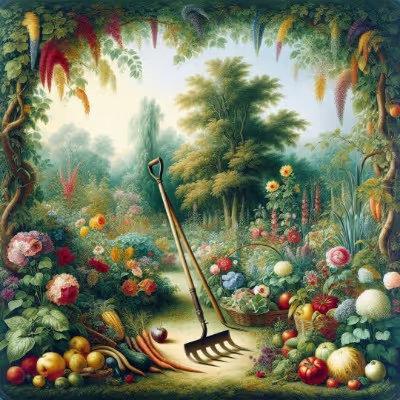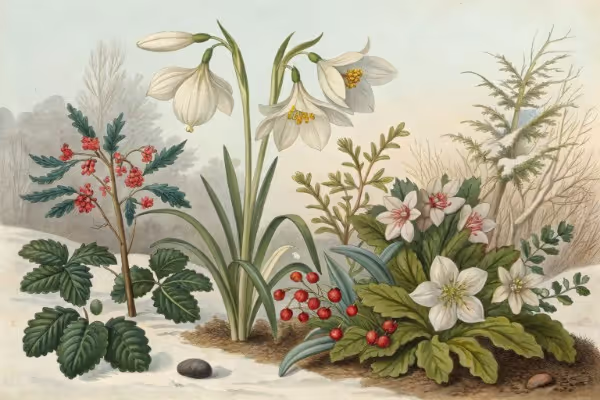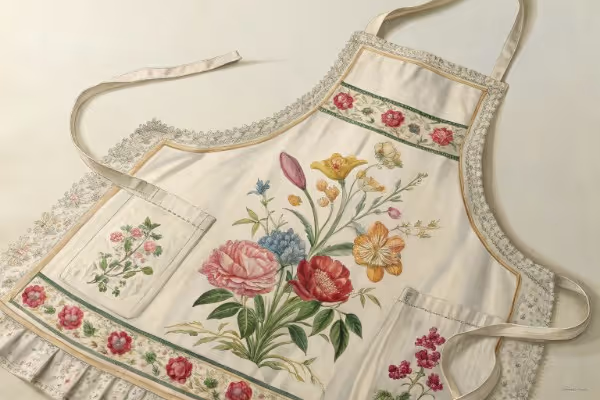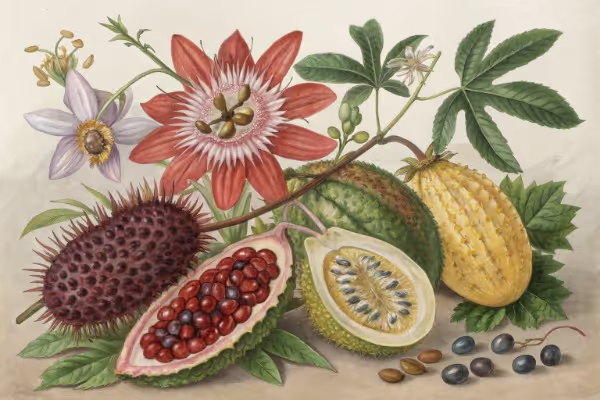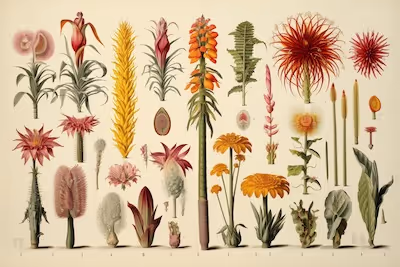What to Plant in February for a Healthy Spring Garden

What to plant in February
Wondering what to plant in February? Root hardy veggies like kale and carrots, sow fragrant sweet peas, and get your summer tomatoes started indoors. February planting sets your garden up for months of vibrant growth—keep reading to discover other veggies, herbs, and blooms primed for late winter planting.
Cheatsheet: February Garden Planting Guide
🌿 Cool-Weather Vegetables
- Direct sow: spinach, radishes, peas, arugula
- Soil temp ≥ 40°F/4°C
- Seeds indoors: broccoli, lettuce, cabbage, kale, celery, leeks, onions
- Start 6-8 weeks before last frost
🌱 Herbs to Kickstart Indoors
- Parsley, chives, dill, cilantro
- 74% germination rate improves with early sowing
🌺 Flowers for Early Color
- Sow indoors: snapdragons, pansy, calendula, sweet pea
- Seeds require 60-68°F/15-20°C
🍠 Root Crops to Direct Sow
- Carrots, beets, parsnips
- Loosen soil to 12”/30cm
🟢 Frost-Hardy Greens
- Sow: mustard greens, Swiss chard, tatsoi, mache
- Boosts vitamin C and K intake
🌡️ Planting Tips by Region
- Zones 5-7: Start indoors, protect with cloches/cold frames
- Zones 8-10: Direct sow many crops outside
🛠️ Tools and Products You'll Need
- Seed trays, peat pots, seedling heat mat
- LED grow lights, clear humidity dome
- Moist seed-starting mix, sharp dibber
- Light row cover, slug traps
🧑🌾 Steps to Plant
- Prep beds: Remove weeds, amend soil with compost
- Firm soil; rake smooth for even sowing
- Sow seeds: Check depth & spacing per packet
- Water gently; keep moist (not soggy)
- Label rows/containers
- Thin seedlings at 2" tall (5cm) for airflow
- Harden off indoor starts before transplanting
I plan from my last expected spring frost date, not the calendar, then work backward 2 to 10 weeks. NOAA and local extension offices publish frost normals that keep me honest.
Recent USDA data shows many areas shifted warmer by about a half-zone in the 2023 Plant Hardiness Zone Map, but I still hedge with row cover and cold frames.
- Zones 3 to 5: Start indoors now: onions, leeks, celery, celeriac, parsley, broccoli, cauliflower, cabbage, kale, lettuce, peppers for a long runway, and perennial flowers like echinacea.
- Zones 3 to 5: Outdoors under cover if soil is workable: spinach, mache, claytonia, scallions, radish, and peas under a low tunnel of fabric rated 0.9 to 1.5 oz per sq yd.
- Zones 6 to 7: Direct sow late month: peas, spinach, arugula, radish, and spring carrots in compost-rich soil when it hits 45 to 50 F (7 to 10 C).
- Zones 6 to 7: Start indoors late month: tomatoes and basil, and keep brassica sowings rolling.
- Zones 8 to 9: Set out potatoes, transplant broccoli and cabbage, and direct sow beets, carrots, cilantro, dill, and chard.
- Zones 8 to 9: Start warm lovers indoors if you prefer transplants: cucumbers, squash, and melons toward month’s end.
- Zones 10 to 11: Plant warm-season workhorses now outdoors, then succession sow every 2 to 3 weeks for sustained harvests.
I use a sterile seed mix, bottom heat, and bright light at seedling height. The difference in stocky growth is night and day.
Most vegetables germinate best at 70 to 75 F (21 to 24 C), while cool brassicas sprout fine at 65 F (18 C). I give seedlings 14 to 16 hours of light at 4000 to 6500 K.
“Provide seedlings with 14 to 16 hours of light daily and keep lights 2 to 3 inches above the canopy.” University of Minnesota Extension
Soil blocks cut plastic waste and develop strong root architecture. Plug trays work too if you manage water and air flow.
I water from the bottom, brush the tops with my hand every day, and run a clip fan for airflow. That simple routine keeps damping-off at bay.
Peas germinate at 40 F (4 C) but sprint at 60 to 75 F (16 to 24 C). I pre-soak 8 hours, then dust with inoculant for a richer root zone.
“Pea seed germination begins near 40 F, improves as soils warm, and seed rots increase in cold, saturated beds.” Iowa State University Extension
Spinach wants cool soil around 45 to 55 F (7 to 13 C). I sow thick, thin early, and mulch with shredded leaves to hold moisture.
Radishes give me quick wins in 24 to 35 days. Fast feedback cures winter rust and sharpens timing for spring.
What to plant in February for color starts under cover. I sow sweet peas in deep cells, plus snapdragons, pansies, violas, calendula, larkspur, poppies, and nigella.
“Sow sweet peas in late winter under cover in deep pots for stout roots and earlier blooms.” Royal Horticultural Society
I pinch sweet peas at 3 to 4 inches and harden them off as soon as the ground can be worked. They shrug off chilly nights with a bit of fleece.
February is prime for bare-root fruit trees, roses, cane berries, asparagus crowns, and rhubarb, as long as the soil isn’t waterlogged or frozen. Dormant roots establish fast in cool, moist soil.
I soak roots 1 to 2 hours, prune broken tips, and set the graft union 2 to 3 inches above grade. Then I water in with 5 to 10 liters (1 to 2.5 gallons) per plant.
I chit seed potatoes in bright, cool light at 50 to 60 F (10 to 16 C) for two weeks. Plant once soil reaches 45 F (7 C) and isn’t sticky.
Onion strategy matters. Long-day types suit northern latitudes, short-day types thrive in the South, and day-neutral types serve the middle belt.
“Onion bulbing is triggered by day length, not plant age.” Cornell Cooperative Extension
I start onion seed 10 to 12 weeks before transplanting or set out onion sets in late February in mild zones. I aim for 4 to 6 plants per square foot with rich, weed-free beds.
February still gives me a cold window for species like milkweed, rudbeckia, and prairie dropseed. I sow in flats outdoors to let chill and moisture do the work.
Label everything with pencil. Marker ink fades faster than a sunny thaw.
I top-dress beds with 2 to 5 cm (1 to 2 inches) of mature compost and a light sprinkle of balanced organic fertilizer, then let snow and rain settle it. Cold soils mineralize nutrients slowly, so I focus on biology, not brute force NPK.
A $20 soil test beats guesswork. I correct pH to 6.2 to 6.8 for most vegetables and add sulfur or lime in small, well-timed doses.
- LED shop lights at 4000 to 6500 K, 200 to 400 PPFD at canopy, 14 to 16 hours daily.
- Heat mat sized to a 10 by 20 tray with a thermostat set to 70 to 75 F (21 to 24 C).
- Plug trays or soil blocks, a fine seed mix, vermiculite for top-dressing, and bottom-watering trays.
- Oscillating clip fan and a digital soil thermometer. Cheap, effective, essential.
- Row cover 0.9 to 1.5 oz per sq yd and a stack of U-pins for quick frost protection.
University and RHS guidance backs these specs, and my spring plants look stout instead of leggy. The right light and steady temps turn February effort into April abundance.
- Leafy greens: spinach, lettuce, arugula, Asian greens, mache, claytonia.
- Roots: radish, beet, carrot, turnip, spring onion, shallot sets in mild zones.
- Legumes: peas outdoors as soil allows, fava beans in cool, maritime climates.
- Brassicas: broccoli, cabbage, cauliflower, kale started indoors nationwide.
- Alliums: onion seed, leeks, onion sets where winters are mild.
- Nightshades: peppers in most zones and tomatoes from zones 6 to 9 late month.
- Tubers and crowns: potatoes, asparagus, rhubarb, Jerusalem artichoke.
- Herbs: parsley, chives, cilantro direct in cool soil, basil under lights.
- Flowers: sweet peas, snapdragons, pansies, violas, larkspur, poppies, calendula, nigella.
- Brassicas: sow 6 to 8 weeks before last frost. Transplant 2 to 4 weeks before last frost.
- Onions and leeks: sow 10 to 12 weeks before transplant. Plant out when soil hits 45 F (7 C).
- Peppers: sow 8 to 10 weeks before last frost. Keep at 75 to 80 F (24 to 27 C) for germination.
- Tomatoes: sow 6 to 8 weeks before last frost. Pot up once to avoid lanky stems.
- Sweet peas: sow in February. Plant out as soon as ground is workable.
- Potatoes: plant when soil is 45 to 50 F (7 to 10 C). Hill twice as shoots reach 6 inches (15 cm).
A late freeze once iced my pea trellis like a sculpture. I tossed row cover over the bed at dusk and still picked pods three weeks earlier than my neighbor.
I stagger sowings every two weeks in February to smooth out the spring glut. That cadence turns feast-and-famine into steady, sane harvests.
USDA Plant Hardiness Zone Map 2023 update, NOAA climate normals for frost dates, and your state or county extension keep timing tight. Royal Horticultural Society advice on late winter sowing and chitting potatoes lines up with my results.
“Know your frost dates, watch soil temperature, and protect tender starts.” Cooperative Extension mantra heard in every winter workshop

Want smarter plant choices? 🪴
Frequently Asked Questions About February Planting
Which vegetables thrive when started in February?
Cold-hardy vegetables such as spinach, kale, Swiss chard, and peas grow vigorously when planted in February. These crops tolerate cooler soil temperatures (around 40°F or 4°C) and can germinate with minimal warmth.
Can I plant flowers outdoors during this month?
Yes, certain hardy flowers like pansies, snapdragons, and sweet peas can be sown directly outdoors in February if your region experiences mild winters. For colder climates, start these blooms indoors and transplant after frost risks diminish.
Which herbs are suitable for indoor starting in February?
Herbs such as basil, parsley, thyme, and oregano germinate reliably when seeded indoors in February. Provide bright sunlight or fluorescent grow lights and maintain indoor temperatures between 60°F–70°F (15°C–21°C) for optimal germination.
Is February too early for planting fruit trees?
No, February marks an ideal time to establish dormant fruit trees such as apple, pear, plum, and certain berry bushes, provided your local ground isn't frozen. Ensure soil conditions allow for proper drainage and root establishment.
What soil preparation methods work best for February sowing?
In February, improve planting areas by incorporating a layer of well-rotted compost or aged manure into the soil. Thoroughly loosen and aerate the top 8–10 inches (20–25 cm) to encourage vigorous root development and nutrient absorption.
Should seedlings started indoors in February be fertilized?
Seedlings initially draw nutrients from their seed coats, but once true leaves appear, apply a diluted liquid fertilizer every two weeks. Select a balanced, water-soluble fertilizer (such as a 10-10-10 N-P-K formula) at half strength to gently encourage healthy growth without overstimulation.
So, what to plant in February? This is your chance to get a jump on the season. Think cold-hardy greens like spinach, kale, and arugula. Drop in peas and radishes if the soil lets you. If you’ve got a greenhouse or a sunny windowsill, start tomatoes and peppers indoors. Don’t skip the companions—pairing the right crops can make all the difference. And if you want more punch from your harvest, check out nutrient-dense vegetables for ideas.
February’s about grit and patience. Plant now, and you’ll be eating fresh when everyone else is still thumbing seed catalogs. Trust the process, keep the soil warm, and don’t be afraid to experiment. You’ll thank yourself come spring.
The Homesteader's Take: February Planting for Self-Sufficient Gardens
Early Crops to Extend the Harvest
- Fava Beans: Cold-hardy protein source; fixes nitrogen to enrich soil naturally.
- Spinach: Rapid growth; frost-resistant leaves for vitamins A, C, and iron.
- Radishes: Ready to harvest in 4-5 weeks; edible roots and greens for quick nutrition.
Strengthen the Soil Organically
- Cover Crop Management: Turn winter rye or clover into soil 3-4 weeks before planting for organic matter boost.
- Composting Timing: Add compost now; allows beneficial microbes to activate before main planting.
- Wood Ash Use: Sprinkle wood ash lightly to provide potassium and calcium; helps balance acidic garden beds.
Boost Yield via Companion Planting
Interplant garlic cloves around fruiting shrubs and vines—natural pest deterrent.
Pair peas with carrots to enhance nitrogen availability and root growth efficiency.
Practical Tools for February Garden Tasks
- Cold frames or row covers for frost protection.
- Soil thermometer: optimal seed germination between 40-60°F (4-16°C).
- Broadfork for gently loosening soil structure without disrupting microbial life.
Interesting Fact:
Early planting of cool-season crops yields up to 20% greater harvest over delayed spring planting.
Find out which plants will thrive in your garden!
Answer a few fun questions and get custom plant recommendations perfect for your space. Let’s grow something amazing together!

start your season
